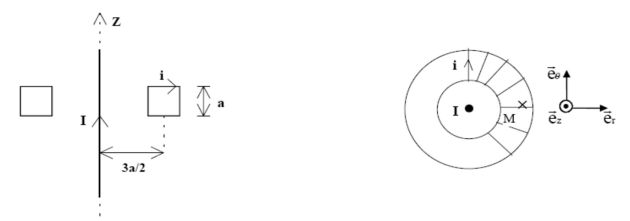Clamp ammeter
Take 15 minutes to prepare this exercise.
Then, if you lack ideas to begin, look at the given clue and start searching for the solution.
A detailed solution is then proposed to you.
If you have more questions, feel free to ask them on the forum.
The usual ammeters cannot bear high intensities (in general
 )
)
To measure higher intensities, a clamp ammeter is used.
The principle is studied here.
An infinite straight wire of axis
 is travelled by a current (the one we want to measure) of intensity :
is travelled by a current (the one we want to measure) of intensity :

The wire is surrounded by a winding made of a square-section torus of side a and medium radius
 .
.
On the torus are regularly wound a great number
 of whorls.
of whorls.
This winding is closed on an ammeter.
The circuit created has a total resistance
 and is travelled, by induction, by a sinusoidal current :
and is travelled, by induction, by a sinusoidal current :

Question
Compute the electromotive force induced by the current
 .
.
There are two magnetic fields, hence two fluxes to compute.
The magnetic field due to the infinite wire is (apply Ampere's law), at a point inside the torus :

The own magnetic field of the torus is (apply Ampere's law) :

The total magnetic field is :

The flux of this total field through the
 whorls of the torus is :
whorls of the torus is :

Hence the electromotive force can be deduced by using Faraday's law of induction :














